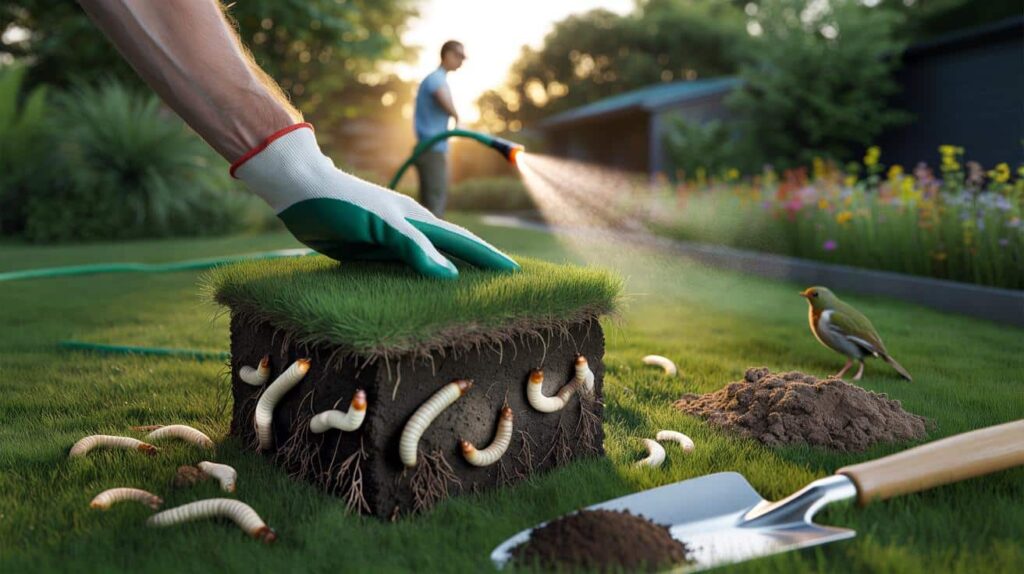This subtle change often leads to bare spots, rolled-up sod, and a summer filled with challenges. The solution rarely begins with products. It starts with the right timing, shade on the soil, and a more consistent care routine.
The initial signs that indicate the presence of white grubs
White grubs are the larvae of scarab beetles, such as chafer and June beetles. They feed on roots. Grass loses its grip and lifts like a rolled carpet. Color changes occur later. Texture reveals the truth first: a soft, springy feel and turf that pulls back too easily.
Observe the wildlife. Starlings, robins, and crows peck into lawns that conceal protein. Heavy bird activity around a patch often indicates grub feeding. Ant mounds and skunk diggings signal similar concerns.
Verify with a quick inspection. Cut a 20 × 20 cm (approximately 8 × 8 in) flap and count what you find. Young grubs curl into a “C” shape, are creamy white, and have a brown head.
Lift a 20 × 20 cm piece of turf. If you find five or more grubs, shift from observation to action.
A straightforward, seasonal strategy that truly works
A retired municipal gardener summarized it as three key points: mow high, keep the soil alive, and act within the correct timeframe. Each step supports the next. The lawn becomes cooler, roots grow deeper, and biological controls effectively target pests.
Mow high to provide shade for the soil
Adjust the mower blade to 7–8 cm (about 3 in). Longer grass blades cast shade on the crown and the topsoil. This shade retains moisture, reduces surface heat, and makes the lawn less appealing to egg-laying adults in early summer.
Set mower height to 7–8 cm. Shade cools the crown and decreases egg-laying pressure.
Maintain the soil’s vitality and openness
Lightly aerate in spring if the ground becomes compacted. Dethatch if the thatch layer exceeds a finger’s thickness. Topdress in late summer with a thin layer of mature, screened compost. The aim is to enhance breathability, not to overhaul the lawn. A living soil encourages stronger roots that can withstand nibbling and recover after stress.
Utilize nematodes at the right time
Nematodes are microscopic allies that target grubs and disrupt them from within. They require moisture to move and mild temperatures to thrive. They are most effective when the larvae are young and close to the surface.
Optimal results: late August through mid-September, evening application, pre-watered lawn, consistent moisture for 10–14 days.
- Pre-water the area in the evening until the top 5–7 cm feels uniformly damp.
- Apply nematodes as instructed, mixing frequently to prevent settling in the tank.
- Keep the soil moist, but not waterlogged, for 10–14 days to assist them in traveling and locating hosts.
- Avoid high-nitrogen fertilization during hot weather; it promotes tender growth that is easily stressed.
What to do when damage has begun
Don’t scalp the lawn. Raise the mower deck and allow the canopy to cool the surface. Manually remove visible grubs while you open the turf. Then, repair the root zone.
Topdress lightly with compost. Overseed with a resilient mix: fine fescues and perennial ryegrass establish quickly and handle summer fluctuations. Water thoroughly to settle the seed and soil. A gentle roll helps the turf reattach to the ground and reduces further egg-laying.
Repair strategy: remove grubs, topdress lightly, overseed with a drought-tolerant mix, water thoroughly, and lightly roll to re-seat roots.
Foster long-term resilience, not short-term appearances
Grubs will not disappear from the landscape. Pressure decreases when the lawn no longer resembles an open buffet. This occurs when the microclimate cools and the food web becomes richer.
Water deeply, but less frequently
Transition from frequent light watering to occasional, thorough soakings. Aim for 2–3 cm of water per session, preferably late in the day. Deep watering encourages roots to grow downward and keeps crowns cooler during hot spells.
Encourage helpers, reduce pressure
Introduce small wildflower strips or native borders at the sun-baked edges. They attract predators and parasitic wasps that help reduce pest populations. Leave about five percent of the yard as “breathing zones” where the soil isn’t compacted and mulch or plants cover bare ground. Gaps in hedges, small brush piles, and water dishes support hedgehogs and birds that forage on grubs. The lawn benefits from the neighborhood cooperating with it, rather than against it.
| Action | When | Why it matters |
|---|---|---|
| Mowing high (7–8 cm) | Growing season | Cools soil, reduces egg-laying, supports deeper roots |
| Sampling (20 × 20 cm flap) | Mid-summer onward | Confirms pressure and triggers treatment at the appropriate threshold |
| Nematodes | Late summer to early fall | Targets young larvae near the surface for optimal control |
| Topdressing with compost | Late summer | Feeds microbes, enhances structure, accelerates recovery |
| Overseeding thin areas | After treatment window | Fills gaps, crowds out weeds, strengthens the turf |
Common mistakes that allow grubs to thrive
- Scalping the lawn in summer, which heats the surface and encourages egg-laying.
- Neglecting moisture before and after applying nematodes, which leaves them stranded.
- Overusing high-nitrogen fertilizer during heat, which weakens crowns.
- Disregarding thatch and compaction, which obstruct roots and water from reaching where they are needed.
Timing varies by climate—observe cues, not calendars
Beetles generally lay eggs from June through July in warmer summer regions. Further north or at higher elevations, this window shifts later. The ideal time for nematodes occurs when nights cool, days remain warm, and the soil retains evening moisture. Soil temperatures around 12–25 °C (55–77 °F) keep nematodes active. Apply on calm evenings. Avoid bright sunlight that dries the surface and diminishes their effectiveness.
Costs, risks, and practical alternatives
Biological controls such as nematodes are less expensive than resodding and do not harm pollinators. A homeowner can treat 90–185 m² (1,000–2,000 sq ft) for the cost of a few bags of premium seed. Conventional insecticides may eliminate grubs, but they can also impact non-target organisms and face local restrictions. Many areas limit summer applications near runoff or wells. Consult local guidelines and adhere to label directions if you choose that option.
If pressure returns the following year, adjust the system instead of increasing product use. Introduce shade where the soil overheats, aerate compacted areas with a garden fork, and rotate seed mixes. Fine fescues tolerate drought and low fertility, while ryegrass quickly covers repairs. The stronger the mix, the fewer opportunities grubs have to disrupt the balance.
Small, consistent changes—shade, moisture, biology, and timing—transform a stressed lawn into a more resilient target.
Quick field checklist for this season
- Walk barefoot on the lawn after irrigation; note any spongy or lifting areas.
- Sample two or three locations with an 8 × 8 in flap; count grubs and identify hotspots.
- Increase mowing height and keep clippings light to mulch and cool the soil.
- Plan for nematodes in late summer evenings; pre-water and maintain moisture for 10–14 days.
- Topdress thin areas, overseed with fine fescue and ryegrass, then water deeply.
Additional context you can utilize
White grub pressure often fluctuates year to year with rainfall. A wet June promotes egg survival, while severe drought can delay hatching. Monitor rainfall, not just dates. If you manage sports or high-traffic turf, consider patching with sod after treatment while seedlings establish in adjacent areas. This way, play can continue without delay in recovery.
For smaller yards, a single 10-liter watering can with a hose-end mixer can evenly apply nematodes. For larger areas, divide the lawn into sections and refill the sprayer frequently to prevent settling. Keep the routine straightforward and repeatable. The lawn adapts to your rhythm—and grubs find fewer opportunities to establish themselves.








